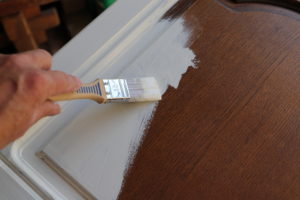
Between cabinets, hardware and installation, new cabinets can eat up 30 percent of your overall kitchen remodeling cost. So, if you want a new-looking kitchen that won’t break the bank, cabinet paint or stain for your existing cabinets may be the way to go.
Painting Your Cabinets: Step by Step
Painting your own kitchen cabinets is one of the most difficult and time-consuming things you can do as a homeowner. It requires time, tools and experience to get the best result. If you’re thinking of tackling this project yourself, here’s what you should know.
Here are the steps expert painters follow to get a professional look during cabinet painting:
- Empty the cabinets.
- Clean and degrease all surfaces, including hardware.
- Remove hardware.
- Remove drawers and doors.
- If you’re going from paint to stain, remove the old paint down to the wood. Otherwise, skip to the next step.
- Sand* the cabinets, including the doors; if you’re painting inside the cabinets, sand the inside, too.
- Fill any cracks or dings with wood filler.
- Prime the cabinets.
- Paint or stain doing two or three coats as needed.
- Let dry then reassemble and reload the cabinets.
Cabinet Paint Versus Stain
One of the first steps when painting cabinets is choosing between paint and stain. Stain comes in a variety of natural hues. It enhances the wood grain of the cabinets and provides color and protection.
Paint, on the other hand, covers the wood entirely. It gives you a wider range of colors to choose from and fits more home styles.
Matching Your Finish to Your Home’s Style
Speaking of style, here are some ideas for how to pair cabinet paint or stain with your vibe.
Rustic or cabin – Natural wood rules in this style of home, so consider staining your cabinets to bring out the warm wood tones.
Cottage or farmhouse – These styles can lean either way, toward paint or stain, depending on your esthetic. But as a rule of thumb, cottage and farmhouse cabinets are often painted white or a simple color like blue, green or gray.
Transitional and modern – Painted cabinets work well in transitional and modern homes, giving their often-neutral color schemes a focal point.
Traditional – Traditional homes rock the stain, though you can certainly branch out to paint. Just keep it in a historic or traditional color in line with the home’s décor.
Price Differences
Cost-wise there’s no real difference between cabinet painting and staining professionally. They both cost between $4 and $10 per square foot.
Cabinet Paint: DIY or DIFM?
Should you do this job yourself or hire a professional interior painter to do it for you? Because of the depth of work and the level of skill involved (not to mention the tools you’ll need) this is one job we recommend hiring out. Why not check out our cabinet painting service for more ideas? Then reach out for a free estimate.
Always refer to your paint and stain product label for safety and application details.
*WARNING! If you scrape, sand, or remove old paint, you may release lead dust. LEAD IS TOXIC. EXPOSURE TO LEAD DUST CAN CAUSE SERIOUS ILLNESS, SUCH AS BRAIN DAMAGE, ESPECIALLY IN CHILDREN. PREGNANT WOMEN SHOULD ALSO AVOID EXPOSURE. Wear a NIOSH-approved respirator to control lead exposure. Clean up carefully with a HEPA vacuum and a wet mop. Before you start, find out how to protect yourself and your family by contacting the National Lead Information Hotline at 1-800-424-LEAD or log on to www.epa.gov/lead.